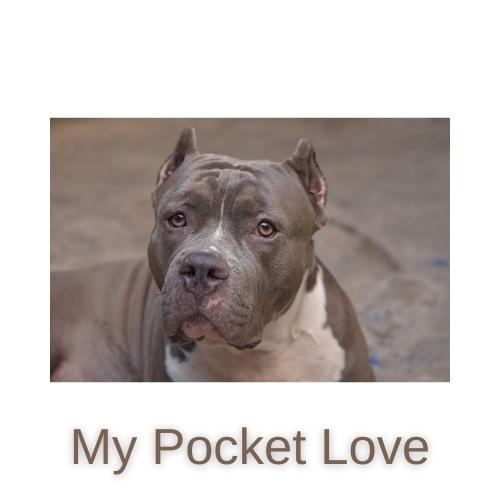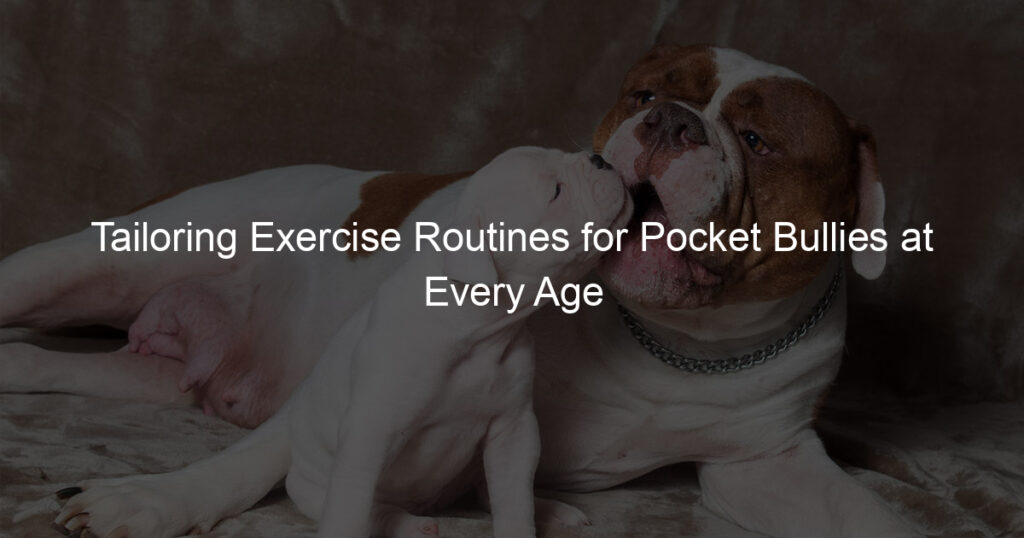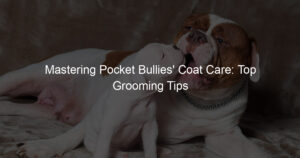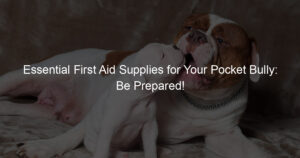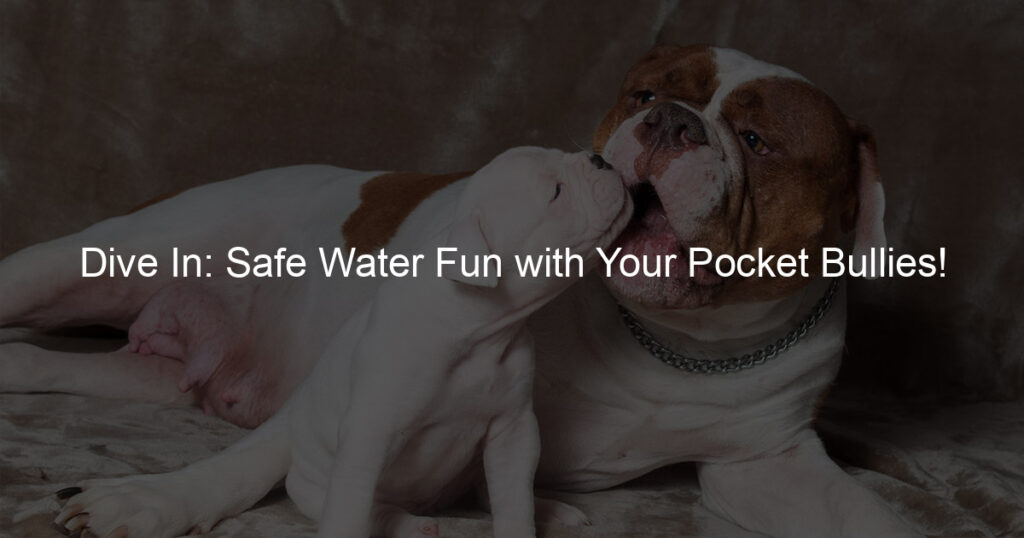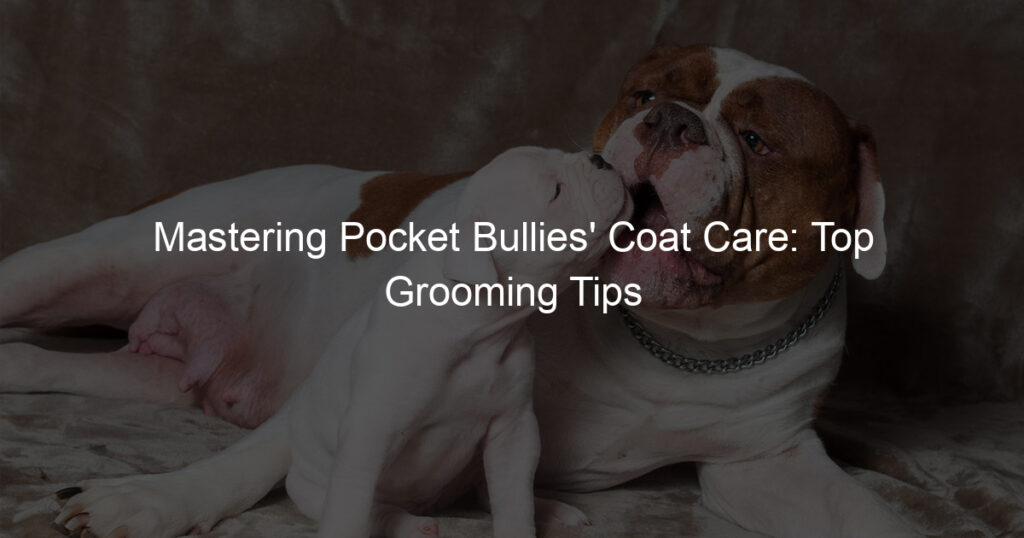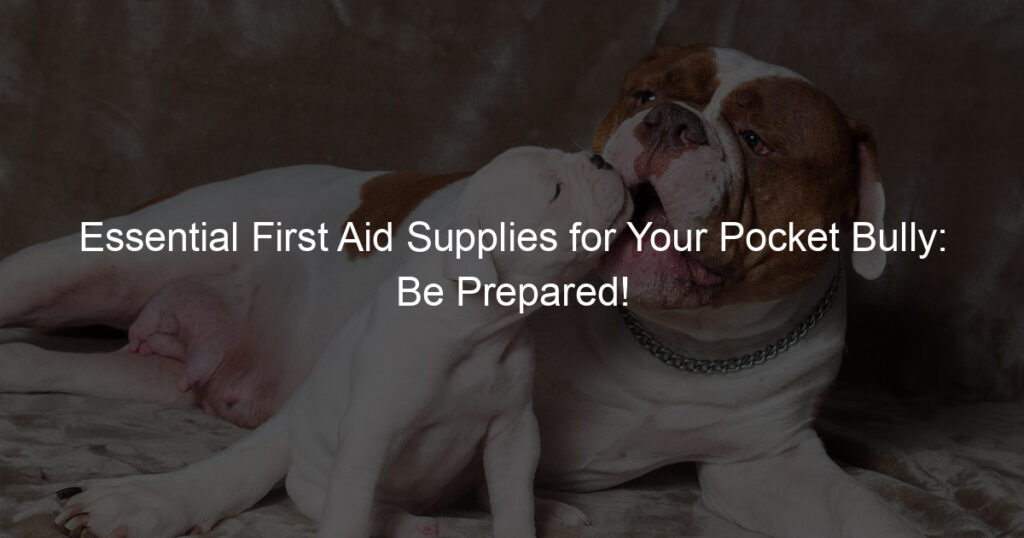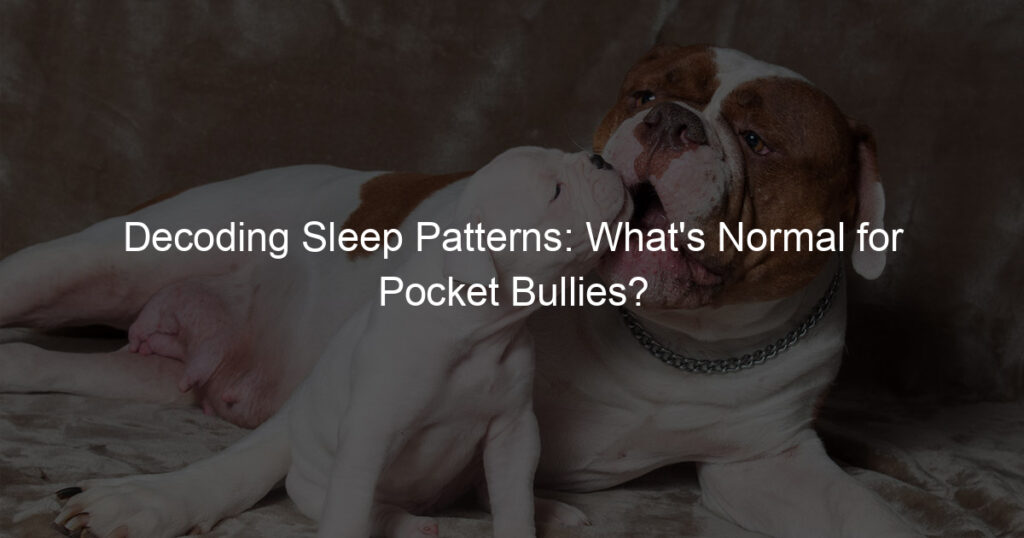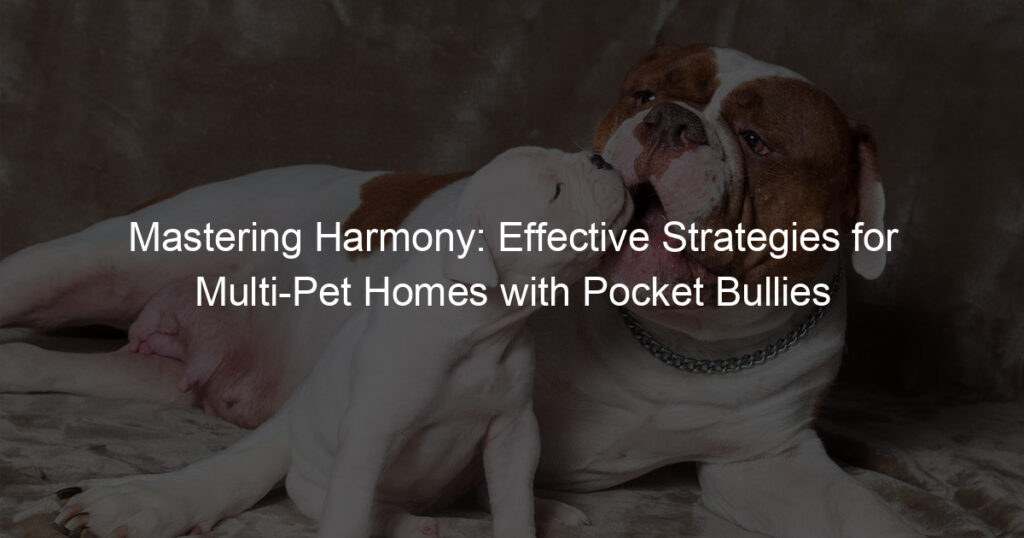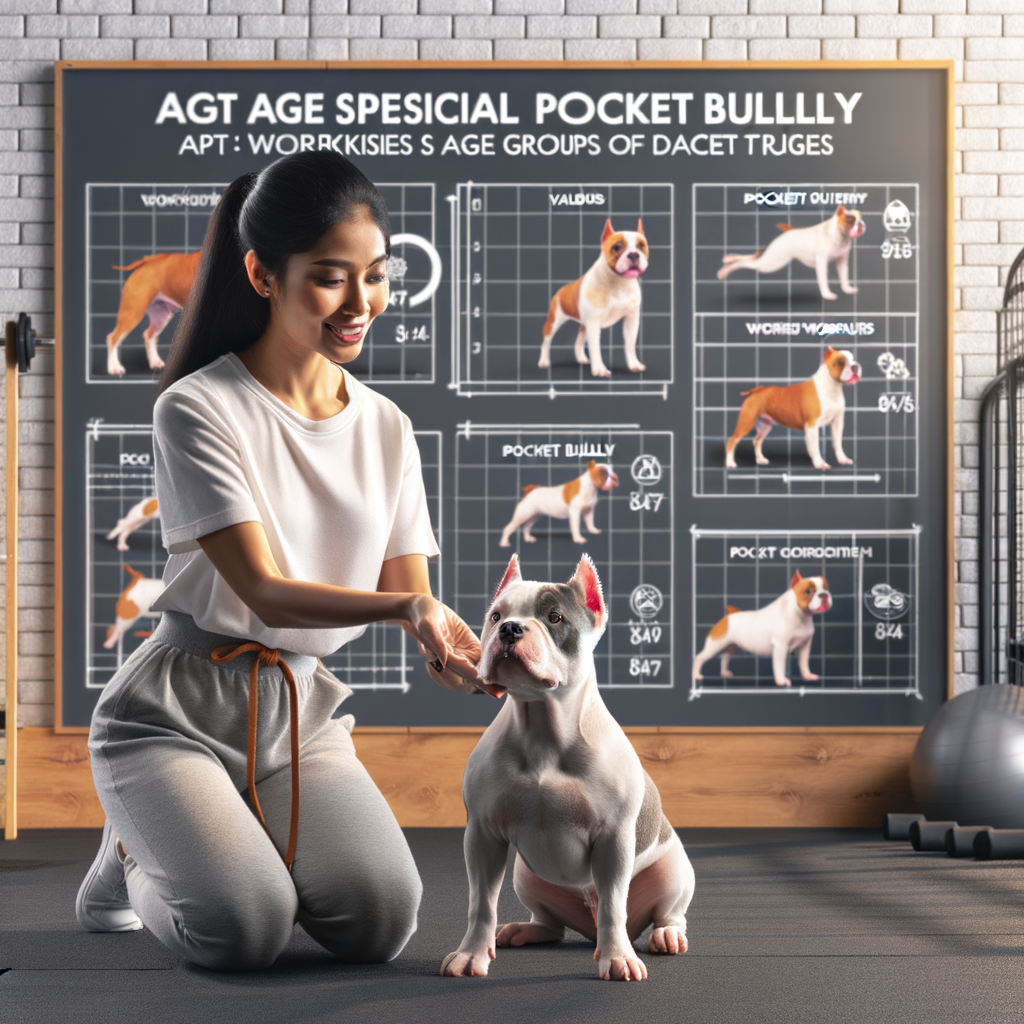
Introduction to Pocket Bullies Exercise Guide
As a responsible pet owner, it’s crucial to understand the importance of regular exercise for your Pocket Bullies. This breed, known for its muscular build and compact size, requires a particular type of care and exercise regimen to maintain its health and happiness. In this guide, we will explore the importance of regular exercise for Pocket Bullies and understand their unique physical needs.
- Importance of Regular Exercise for Pocket Bullies
Regular exercise is essential for Pocket Bullies for several reasons. Firstly, it helps maintain their physical health. Pocket Bullies are muscular dogs, and regular exercise helps keep their muscles toned and healthy. It also helps control their weight, as this breed can be prone to obesity if not properly exercised.
Secondly, exercise is crucial for their mental health. Pocket Bullies are intelligent dogs that need mental stimulation to prevent boredom and destructive behavior. Regular exercise, particularly activities that challenge them mentally, can provide this stimulation.
Lastly, exercise helps improve their behavior. Regular physical activity can help reduce common behavioral problems in Pocket Bullies, such as excessive barking, chewing, or digging. It can also help make them more relaxed and less aggressive.
- Understanding the Unique Physical Needs of Pocket Bullies
Pocket Bullies have unique physical needs due to their muscular build and compact size. They require a moderate amount of exercise, but it should not be too strenuous as it can put too much pressure on their joints.
Activities such as walking, light jogging, and playing fetch are ideal for this breed. They also enjoy agility training, which not only provides physical exercise but also mental stimulation.
It’s also important to remember that Pocket Bullies are prone to overheating due to their short snouts. Therefore, exercise should be done during the cooler parts of the day, and they should always have access to fresh water.
In conclusion, understanding and catering to the unique physical needs of your Pocket Bullies will ensure they lead a healthy and happy life. Remember, a well-exercised dog is a happy dog!
Understanding Age-Specific Exercises for Pocket Bullies
Exercising your Pocket Bully is crucial for their health and happiness. But it’s not one-size-fits-all. The type and amount of exercise your dog needs changes as they grow. Let’s explore the puppy stage, from birth to six months.
Puppy Stage (0-6 months)
During the first six months of your Pocket Bully’s life, exercise is more about exploration and play than rigorous workouts. It’s a time for your puppy to learn about their body, their environment, and how to interact with the world around them.
- Introduction to Exercise
- Safe Exercises for Puppies
- How Much Exercise is Too Much?
Introducing your Pocket Bully puppy to exercise should be a gentle process. It’s about encouraging them to move, play, and explore. Simple games like fetch or tug-of-war can be great starters. Remember, the goal is not to tire them out but to stimulate their minds and bodies.
Safe exercises for Pocket Bully puppies include short walks, gentle play sessions, and basic training exercises like sit, stay, and come. Avoid high-impact activities like jumping or running on hard surfaces, as these can harm their developing joints.
Over-exercising a puppy can lead to long-term health problems. A good rule of thumb is five minutes of exercise per month of age, up to twice a day. So, a three-month-old puppy should have no more than 15 minutes of structured exercise at a time. Remember, this doesn’t include their regular playtime.
Understanding your Pocket Bully’s exercise needs at each stage of life will help you provide the best care for your furry friend. Stay tuned for our next section where we’ll discuss the exercise needs of adolescent Pocket Bullies.
Adolescent Stage (6-12 months)
As your Pocket Bully transitions into the adolescent stage, their exercise needs will change. This period is marked by a significant increase in energy and curiosity. Therefore, it’s crucial to adjust their exercise routine to meet these new demands.
- Transitioning to More Active Exercises
- Training Tips for Adolescent Pocket Bullies
- Consistency is Key: Maintain a regular exercise schedule. This helps your dog understand what to expect and reduces anxiety.
- Positive Reinforcement: Always reward good behavior with treats, praises, or extra playtime. This encourages your dog to repeat the behavior.
- Patience: Remember, your Pocket Bully is still learning. Be patient and give them time to understand new commands and exercises.
During the adolescent stage, your Pocket Bully is ready to engage in more active exercises. This is the perfect time to introduce activities that require more energy and agility. For instance, fetch games, tug-of-war, and agility training can be gradually incorporated into their routine. Remember, the goal is not to exhaust your dog but to help them burn off energy and stay fit.
Training your adolescent Pocket Bully can be a rewarding experience if done correctly. Here are some tips:
In conclusion, the adolescent stage is a crucial time for your Pocket Bully. By transitioning to more active exercises and following the right training tips, you can ensure your dog stays healthy and happy during this period.
| Exercise | Benefits |
|---|---|
| Fetch games | Improves agility and burns energy |
| Tug-of-war | Strengthens muscles and promotes mental stimulation |
| Agility training | Enhances coordination and provides mental challenge |
Adult Stage (1-8 years)
When your Pocket Bully reaches the adult stage, which is from 1 to 8 years old, it’s crucial to maintain a consistent exercise routine and adapt exercises that are suitable for their age and physical condition. Let’s delve into these two important aspects.
- Maintaining a consistent exercise routine
- Adapting exercises for adult Pocket Bullies
Consistency is key when it comes to exercising your adult Pocket Bully. Regular exercise not only keeps your dog physically fit but also mentally stimulated. A consistent routine can include daily walks, playtime, and training sessions. Remember, it’s not about the intensity of the exercise, but the regularity. A 30-minute walk daily is better than a 2-hour walk once a week.
As your Pocket Bully matures, their exercise needs may change. It’s important to adapt their exercise routine to suit their age, health, and energy levels. For example, if your Pocket Bully is highly energetic, you might want to include more vigorous activities like running or agility training. On the other hand, if your dog prefers a slower pace, a leisurely walk or a game of fetch might be more suitable.
Here’s a simple table to help you understand the exercise needs of your adult Pocket Bully:
| Age | Exercise Needs | Examples |
|---|---|---|
| 1-3 years | High | Running, agility training, fetch |
| 4-6 years | Moderate | Brisk walking, tug-of-war, hide and seek |
| 7-8 years | Low | Leisurely walking, gentle playtime |
Remember, every Pocket Bully is unique and their exercise needs can vary. Always monitor your dog during exercise to ensure they are not overexerting themselves. If you notice any signs of discomfort or fatigue, it’s time to take a break. With the right exercise routine, your Pocket Bully can enjoy a healthy and happy life.
Senior Stage (8+ years)
As our beloved Pocket Bullies enter their senior years, their exercise needs change. It’s crucial to adjust their routines to keep them healthy and happy. Let’s explore how we can do this.
- Adjusting exercise routines for senior dogs
Senior Pocket Bullies may not have the same energy levels as their younger counterparts. However, this doesn’t mean they should stop exercising. Instead, their routines should be adjusted to accommodate their changing physical capabilities.
For instance, instead of long, strenuous walks, consider shorter, more frequent walks. This can help keep your senior Pocket Bully active without overexerting them. Similarly, playtime should be less intense. Opt for gentle games that won’t put too much strain on their joints.
Remember, every dog is unique. It’s essential to monitor your Pocket Bully’s response to these changes and adjust accordingly. If they seem tired or in pain, it might be time to reduce the intensity even further.
- Exercise tips for aging Pocket Bullies
Here are some tips to help you keep your aging Pocket Bully active and healthy:
- Warm-ups and cool-downs: Just like humans, dogs need to warm up before exercising and cool down afterwards. This can help prevent injuries and muscle strain.
- Regular vet check-ups: Regular vet visits can help detect any potential health issues early. Your vet can also provide personalized exercise recommendations based on your Pocket Bully’s health.
- Hydration: Ensure your Pocket Bully has access to fresh water before, during, and after exercise. This is especially important in hot weather to prevent dehydration.
- Comfortable environment: Make sure the exercise environment is comfortable for your senior dog. Avoid hot pavement or icy surfaces that could hurt their paws.
Remember, exercise is just one aspect of your Pocket Bully’s overall health. Proper diet, regular vet check-ups, and lots of love and attention are equally important in their golden years.
Training Pocket Bullies: Exercise and Discipline
Training your Pocket Bullies involves more than just physical activity. It also requires discipline. Let’s delve into the importance of discipline in exercise routines and explore some effective training techniques.
- Importance of discipline in exercise routines
Discipline is the backbone of any successful exercise routine. It’s not just about making your Pocket Bullies do a set of exercises. It’s about consistency, persistence, and patience. When you maintain discipline in your pet’s exercise routine, you help them develop a healthy habit. This not only keeps them physically fit but also mentally sharp.
According to a study, dogs that follow a disciplined exercise routine are less likely to develop behavioral problems. They are more obedient, more focused, and less likely to engage in destructive behavior. So, discipline in exercise routines is not just for their physical health, but also for their overall well-being.
- Training techniques for effective workouts
Now that we understand the importance of discipline, let’s look at some training techniques that can make your Pocket Bullies’ workouts more effective.
Firstly, always start with a warm-up. This prepares your pet for the exercise session and reduces the risk of injuries. You can do this by taking a short walk or playing a light game of fetch.
Next, use positive reinforcement. This means rewarding your pet when they do something right. This could be a treat, a pat on the back, or verbal praise. This encourages them to repeat the behavior, making the training more effective.
Lastly, keep the training sessions short but regular. Pocket Bullies have a short attention span, so long training sessions may not be effective. Instead, have shorter sessions more frequently. This keeps them engaged and makes the training more effective.
Remember, the key to effective workouts is consistency and patience. It may take time, but with the right techniques and discipline, your Pocket Bullies can enjoy a healthy and active lifestyle.
Creating a Pocket Bullies Workout Schedule
Creating a workout schedule for your Pocket Bullies is a crucial step in ensuring their overall health and happiness. This process involves understanding your dog’s energy levels, creating a balanced workout routine, and adjusting the routine as your dog ages.
- Understanding your dog’s energy levels
Every dog is unique, and so is their energy level. Pocket Bullies are known for their high energy levels, which means they require regular exercise to stay fit and healthy. Monitor your dog’s behavior during different activities to get a sense of their energy levels. For example, if your dog is still energetic after a long walk, it might need more intense exercise like a game of fetch or tug-of-war.
- Creating a balanced workout routine
A balanced workout routine for your Pocket Bullies should include a mix of physical exercise and mental stimulation. Physical exercise can include walks, playtime, and agility training. Mental stimulation can be achieved through puzzle toys, obedience training, and interactive games. Remember, the goal is not to exhaust your dog but to keep it healthy and engaged.
| Physical Exercise | Mental Stimulation |
|---|---|
| Walks, playtime, agility training | Puzzle toys, obedience training, interactive games |
- Adjusting the routine as your dog ages
As your Pocket Bullies age, their energy levels and physical capabilities will change. It’s important to adjust their workout routine to match their age and health status. Older dogs may not be able to handle the same level of physical activity as they could when they were younger. Instead, focus on low-impact exercises like leisurely walks and gentle playtime. Always consult with your vet to determine the best exercise routine for your aging dog.
In conclusion, creating a workout schedule for your Pocket Bullies requires understanding their energy levels, creating a balanced routine, and adjusting it as they age. By following these steps, you can ensure your dog stays healthy, happy, and active throughout its life.
Pocket Bullies Fitness: Key Takeaways
As we conclude our comprehensive guide on Pocket Bullies fitness, it’s essential to highlight the key takeaways. These are the crucial points that every Pocket Bullies owner should keep in mind to ensure their pet’s optimal health and well-being.
- Importance of Regular, Age-appropriate Exercise
- Benefits of a Consistent Workout Schedule
- Role of Exercise in Overall Health and Well-being of Pocket Bullies
Regular exercise is vital for your Pocket Bullies. It helps them burn off energy, maintain a healthy weight, and stay physically fit. However, it’s crucial to ensure that the exercise is age-appropriate. Puppies require different exercise routines compared to adult dogs. Overexertion can lead to health issues, especially in growing puppies. Therefore, always consult with your vet to determine the right amount and type of exercise for your Pocket Bullies at different stages of their life.
Consistency is key when it comes to your Pocket Bullies’ workout schedule. A regular routine helps your pet understand what to expect, reducing anxiety and behavioral issues. It also ensures that they get the necessary amount of exercise each day. A consistent workout schedule can include daily walks, playtime, and training sessions. Remember, consistency not only benefits your pet’s physical health but also contributes to their mental well-being.
Exercise plays a significant role in the overall health and well-being of your Pocket Bullies. Regular physical activity helps maintain a healthy weight, reducing the risk of obesity-related health issues. It also keeps their joints flexible and muscles strong. Moreover, exercise is an excellent way for your pet to release pent-up energy, reducing behavioral problems. It also provides mental stimulation, keeping your Pocket Bullies mentally sharp and happy. In essence, a well-exercised Pocket Bullies is a healthy and content pet.
In conclusion, regular, age-appropriate exercise, a consistent workout schedule, and understanding the role of exercise in your Pocket Bullies’ overall health and well-being are the key takeaways from our Pocket Bullies Fitness Guide. Remember, a fit and healthy Pocket Bullies is a happy Pocket Bullies!
Case Study: Successful Exercise Routines for Pocket Bullies
In this section, we will look at two case studies that illustrate successful exercise routines for Pocket Bullies at different stages of their lives: from puppyhood to adulthood, and from adulthood to senior years.
-
Case Study 1: Puppy to Adult
Meet Max, a Pocket Bully who was introduced to a structured exercise routine as a puppy. His owner, Lisa, understood the importance of age-specific exercises and started with short, gentle walks and play sessions.
As Max grew, Lisa gradually increased the intensity and duration of his exercises. By the time Max was a year old, he was able to handle more strenuous activities, like fetch games and tug-of-war. Lisa also introduced obedience training to help Max burn mental energy.
Max’s exercise routine included:
Age Exercise Duration Puppy (3-6 months) Short walks, play sessions 15-20 minutes, twice a day Young Adult (6-12 months) Fetch games, tug-of-war, obedience training 30-45 minutes, twice a day Max’s story illustrates the importance of gradually increasing the intensity of exercises as a Pocket Bully grows from a puppy to an adult.
-
Case Study 2: Adult to Senior
Next, let’s look at Bella, a Pocket Bully who maintained an active lifestyle into her senior years. Bella’s owner, John, made sure to adjust her exercise routine as she aged to prevent strain on her joints.
As Bella grew older, John replaced high-impact exercises with low-impact ones, like swimming and leisurely walks. He also incorporated mental stimulation exercises, like puzzle toys, to keep Bella’s mind sharp.
Bella’s exercise routine included:
Age Exercise Duration Adult (1-7 years) Fetch games, tug-of-war, obedience training 45-60 minutes, twice a day Senior (7+ years) Swimming, leisurely walks, puzzle toys 30-45 minutes, twice a day Bella’s story demonstrates the importance of adjusting exercise routines for Pocket Bullies as they transition from adulthood to their senior years.
These case studies highlight the importance of age-specific exercises for Pocket Bullies. By understanding your dog’s needs at each stage of life, you can ensure they stay healthy and happy.
